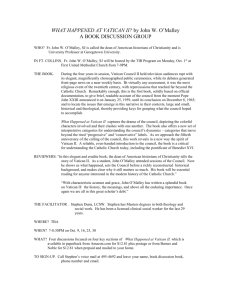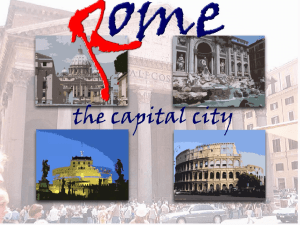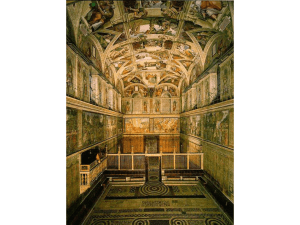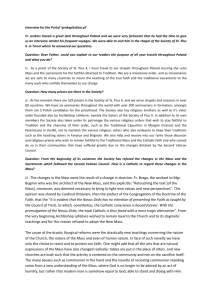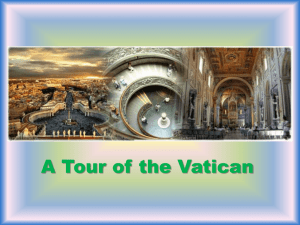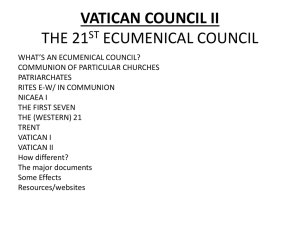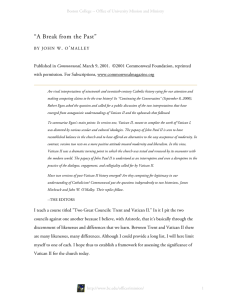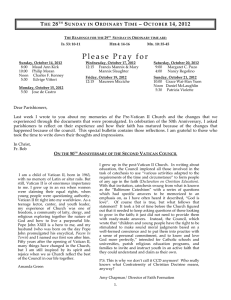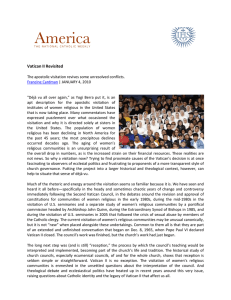Catholicism: Vatican II
advertisement
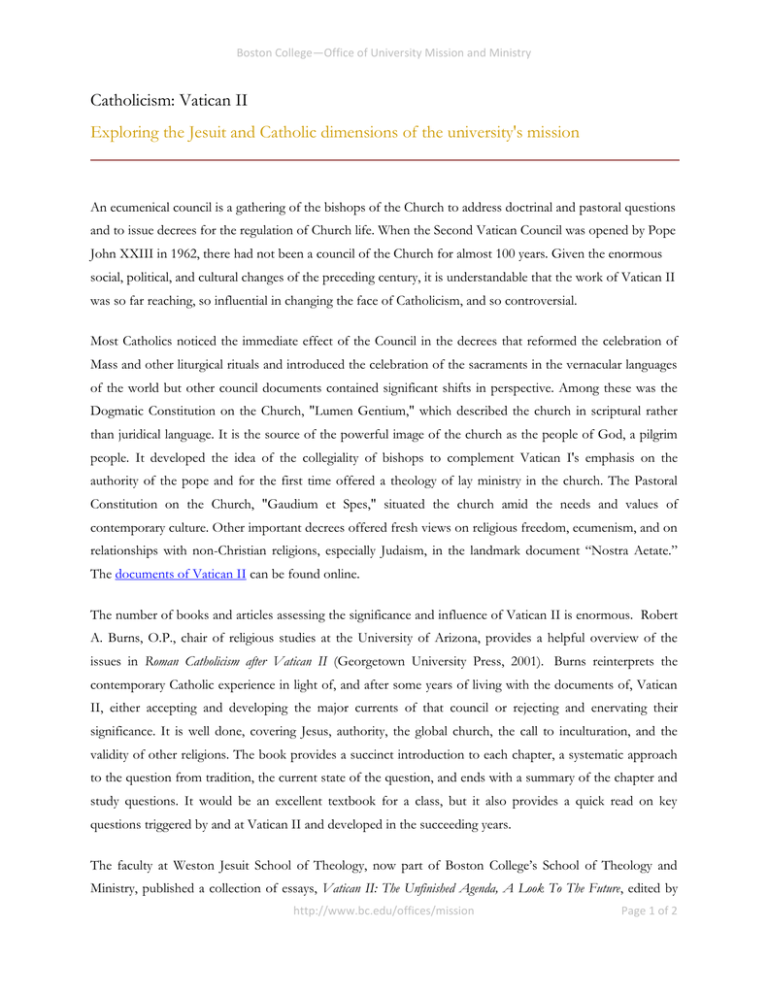
Boston College—Office of University Mission and Ministry Catholicism: Vatican II Exploring the Jesuit and Catholic dimensions of the university's mission An ecumenical council is a gathering of the bishops of the Church to address doctrinal and pastoral questions and to issue decrees for the regulation of Church life. When the Second Vatican Council was opened by Pope John XXIII in 1962, there had not been a council of the Church for almost 100 years. Given the enormous social, political, and cultural changes of the preceding century, it is understandable that the work of Vatican II was so far reaching, so influential in changing the face of Catholicism, and so controversial. Most Catholics noticed the immediate effect of the Council in the decrees that reformed the celebration of Mass and other liturgical rituals and introduced the celebration of the sacraments in the vernacular languages of the world but other council documents contained significant shifts in perspective. Among these was the Dogmatic Constitution on the Church, "Lumen Gentium," which described the church in scriptural rather than juridical language. It is the source of the powerful image of the church as the people of God, a pilgrim people. It developed the idea of the collegiality of bishops to complement Vatican I's emphasis on the authority of the pope and for the first time offered a theology of lay ministry in the church. The Pastoral Constitution on the Church, "Gaudium et Spes," situated the church amid the needs and values of contemporary culture. Other important decrees offered fresh views on religious freedom, ecumenism, and on relationships with non-Christian religions, especially Judaism, in the landmark document “Nostra Aetate.” The documents of Vatican II can be found online. The number of books and articles assessing the significance and influence of Vatican II is enormous. Robert A. Burns, O.P., chair of religious studies at the University of Arizona, provides a helpful overview of the issues in Roman Catholicism after Vatican II (Georgetown University Press, 2001). Burns reinterprets the contemporary Catholic experience in light of, and after some years of living with the documents of, Vatican II, either accepting and developing the major currents of that council or rejecting and enervating their significance. It is well done, covering Jesus, authority, the global church, the call to inculturation, and the validity of other religions. The book provides a succinct introduction to each chapter, a systematic approach to the question from tradition, the current state of the question, and ends with a summary of the chapter and study questions. It would be an excellent textbook for a class, but it also provides a quick read on key questions triggered by and at Vatican II and developed in the succeeding years. The faculty at Weston Jesuit School of Theology, now part of Boston College’s School of Theology and Ministry, published a collection of essays, Vatican II: The Unfinished Agenda, A Look To The Future, edited by http://www.bc.edu/offices/mission Page 1 of 2 Boston College—Office of University Mission and Ministry Lucien Richard, OMI, Daniel Harrington, S.J., and John W. O'Malley. S.J. (New York/Mahweh: Paulist, 1987). The historian John W. O’Malley, S.J., has published a number of studies dealing with the significance of the Council. The climax of his comprehensive work on the topic is detailed but highly readable study, What Happened at Vatican II (Harvard University Press, 2008). O’Malley interprets Vatican II as a different kind of Church council, one that introduced a way of speaking and a methodology based on experience and historical reflection rather than on a philosophical/theological position that presents itself as atemporal. In this methodology, he argues, lies a significant shift of consciousness among the Council’s bishops and much of what we mean by reform and renewal. For two short overviews of the contending arguments about the significance of the Council, see two articles in Commonweal magazine (9 March 2001), one by O’Malley, "A Break from the Past," the other by James Hitchcock, professor of history at Saint Louis University, "A Continuum in the Great Tradition." For an informed and thoughtful account of the experience of growing up Catholic in the aftermath of Vatican II, see "The Making of a Post-Vatican II Theologian: Reflections on 25 Years of Catholic Education," by John J. Markey, O.P. (America, 16 July 1994). http://www.bc.edu/offices/mission Page 2 of 2
